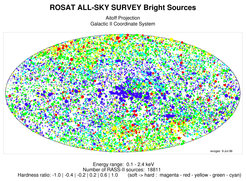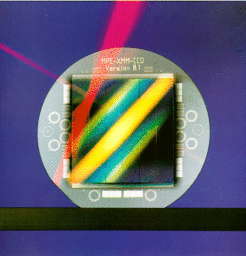Citation landmarks for two high-energy papers

The distribution of the ROSAT All-Sky Bright Sources on the sky.
The ROSAT source catalogue - or more precisely the ROSAT all-sky survey bright source catalogue - was published in 1999, after some eight years of careful and detailed analysis of the data taken in the first half year (1990/91) of the ROSAT mission. One of the main scientific objectives of ROSAT was to conduct the first all-sky survey in X-rays with an imaging telescope leading to a major increase in sensitivity and source location accuracy.
In total some 125,000 sources were detected, but only the brightest 18,811 objects were published in this catalogue (and more than 100 000 in the faint source catalogue). The ROSAT survey was 20 times more sensitive than any previous all-sky survey in X-rays and contained about 25 times as many sources as all other X-ray catalogues at the time. The large number of citations for the catalogue paper - which continue to the present day - reflects the wide and enduring influence of ROSAT on an extraordinary range of astrophysical topics.
"ROSAT provided the first clear evidence that the X-ray background is not truly diffuse, but originates from a large number of individual sources, most of them black holes," says Wolfgang Voges, lead author of the ROSAT paper. "The ROSAT data also played an important role in many studies of galaxy clusters, quasars, active galactic nuclei and other galaxies, supernovae, stars, and even comets."

The 6 cm x 6 cm large pn-CCD at the heart of the EPIC/XMM camera.
The XMM-Newton satellite observatory was launched in December 1999; just a few months after ROSAT had finally stopped operations. With their long experience in X-ray missions, MPE scientists contributed not only to telescope and software development and testing for XMM-Newton but also led the development and manufacturing of the CCDs for its main instrument: The European Photon Imaging Camera (EPIC).
EPIC consists of three cameras, at whose heart are CCDs which register and record the position and energy of incoming X-ray photons. Two of the cameras employ metal oxide semi-conductor (MOS) CCDs, while the third uses a new type of device, the pn-CCD, which was developed and built by semi-conductor laboratory of the MPE.
Development, integration and testing of this novel instrument took almost ten years, but resulted in a detector that is specifically tailored to the requirements of the XMM telescope performance with high detection efficiency, low noise level and fast readout.
"The wafer scale chips needed to be manufactured 'in-house' with extreme precision," explains Lothar Strüder, head of the MPI Semi-conductor Laboratory and lead author on the EPIC paper. "As the pn-CCD is illuminated from the rear side, which does not have insensitive layers or coatings, the X-ray detection efficiency is extremely high and homogeneous from the very low to the highest XMM-Newton energies." The 6 cm × 6 cm sensitive area made it the largest X-ray CCD detector built for space at the time, and it remained so for many years.
Typically, astronomers will cite the EPIC-pn paper each time they use data from the camera in a publication. "Reaching 1000 citations is a remarkable achievement and illustrates the influence and wide reach of the work of scientists in the high energy group," says Kirpal Nandra, Director at MPE.
| Original paper : | ||
| The ROSAT all-sky survey bright source catalogue Voges, W.; Aschenbach, B.; Boller, Th.; Bräuninger, H.; Briel, U.; Burkert, W.; Dennerl, K.; Englhauser, J.; Gruber, R.; Haberl, F.; Hartner, G.; Hasinger, G.; Kürster, M.; Pfeffermann, E.; Pietsch, W.; Predehl, P.; Rosso, C.; Schmitt, J. H. M. M.; Trümper, J.; Zimmermann, H. U. The European Photon Imaging Camera on XMM-Newton: The pn-CCD camera Strüder, L.; Briel, U.; Dennerl, K.; Hartmann, R.; Kendziorra, E.; Meidinger, N.; Pfeffermann, E.; Reppin, C.; Aschenbach, B.; Bornemann, W.; Bräuninger, H.; Burkert, W.; Elender, M.; Freyberg, M.; Haberl, F.; Hartner, G.; Heuschmann, F.; Hippmann, H.; Kastelic, E.; Kemmer, S.; Kettenring, G.; Kink, W.; Krause, N.; Müller, S.; Oppitz, A.; Pietsch, W.; Popp, M.; Predehl, P.; Read, A.; Stephan, K. H.; Stötter, D.; Trümper, J.; Holl, P.; Kemmer, J.; Soltau, H.; Stötter, R.; Weber, U.; Weichert, U.; von Zanthier, C.; Carathanassis, D.; Lutz, G.; Richter, R. H.; Solc, P.; Böttcher, H.; Kuster, M.; Staubert, R.; Abbey, A.; Holland, A.; Turner, M.; Balasini, M.; Bignami, G. F.; La Palombara, N.; Villa, G.; Buttler, W.; Gianini, F.; Lainé, R.; Lumb, D.; Dhez, P. |
||
| Links : | ||
| |
||
last update 2011-11-18 by H. Steinle













